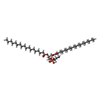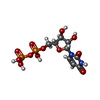+Search query
-Structure paper
| Title | Structure, substrate recognition and initiation of hyaluronan synthase. |
|---|---|
| Journal, issue, pages | Nature, Vol. 604, Issue 7904, Page 195-201, Year 2022 |
| Publish date | Mar 30, 2022 |
 Authors Authors | Finn P Maloney / Jeremi Kuklewicz / Robin A Corey / Yunchen Bi / Ruoya Ho / Lukasz Mateusiak / Els Pardon / Jan Steyaert / Phillip J Stansfeld / Jochen Zimmer /     |
| PubMed Abstract | Hyaluronan is an acidic heteropolysaccharide comprising alternating N-acetylglucosamine and glucuronic acid sugars that is ubiquitously expressed in the vertebrate extracellular matrix. The high- ...Hyaluronan is an acidic heteropolysaccharide comprising alternating N-acetylglucosamine and glucuronic acid sugars that is ubiquitously expressed in the vertebrate extracellular matrix. The high-molecular-mass polymer modulates essential physiological processes in health and disease, including cell differentiation, tissue homeostasis and angiogenesis. Hyaluronan is synthesized by a membrane-embedded processive glycosyltransferase, hyaluronan synthase (HAS), which catalyses the synthesis and membrane translocation of hyaluronan from uridine diphosphate-activated precursors. Here we describe five cryo-electron microscopy structures of a viral HAS homologue at different states during substrate binding and initiation of polymer synthesis. Combined with biochemical analyses and molecular dynamics simulations, our data reveal how HAS selects its substrates, hydrolyses the first substrate to prime the synthesis reaction, opens a hyaluronan-conducting transmembrane channel, ensures alternating substrate polymerization and coordinates hyaluronan inside its transmembrane pore. Our research suggests a detailed model for the formation of an acidic extracellular heteropolysaccharide and provides insights into the biosynthesis of one of the most abundant and essential glycosaminoglycans in the human body. |
 External links External links |  Nature / Nature /  PubMed:35355017 / PubMed:35355017 /  PubMed Central PubMed Central |
| Methods | EM (single particle) |
| Resolution | 2.7 - 3.1 Å |
| Structure data | EMDB-25366, PDB-7sp6: EMDB-25367, PDB-7sp7: EMDB-25368, PDB-7sp8: EMDB-25369, PDB-7sp9: EMDB-25370, PDB-7spa: |
| Chemicals |  ChemComp-Y01:  ChemComp-MN:  ChemComp-3PE:  ChemComp-UDP:  ChemComp-UD1:  ChemComp-NAG: |
| Source |
|
 Keywords Keywords |  MEMBRANE PROTEIN / MEMBRANE PROTEIN /  glycosyltransferase / glycosyltransferase /  hyaluronan hyaluronan |
 Movie
Movie Controller
Controller Structure viewers
Structure viewers About Yorodumi Papers
About Yorodumi Papers













 paramecium bursaria chlorella virus cz-2
paramecium bursaria chlorella virus cz-2
